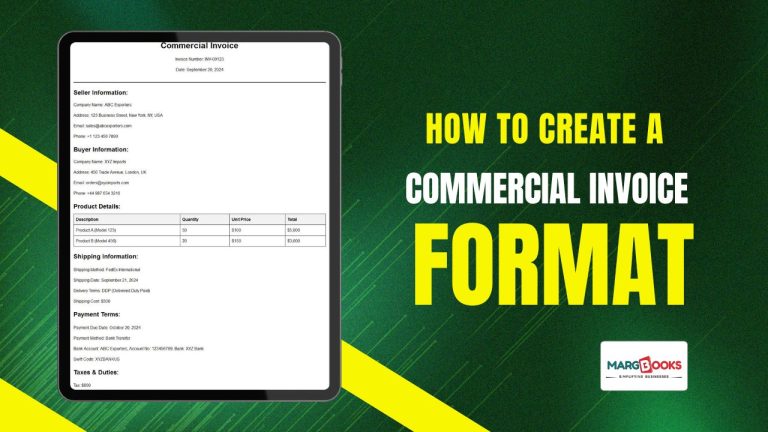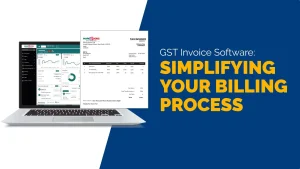A commercial invoice is an important document used in business, especially when buying and selling goods internationally. It acts as proof of the sale between the buyer and seller. This document includes details about the products being sold, the price, and how they will be delivered. We will explain how to create a commercial invoice format, what to include in it, and why it’s important. We’ll keep the language simple and professional to help you understand how to make a clear, detailed invoice that will benefit your business.
What is a Commercial Invoice?
A commercial invoice is a document that shows the agreement between the buyer and seller. It provides information about the products, the price, and how the payment will be made. It’s also required when shipping goods internationally to ensure smooth customs clearance.
Some key reasons why a commercial invoice is important:
- Record Keeping: It helps track the details of each transaction.
- Customs Clearance: For international shipments, the invoice is used by customs to determine taxes and duties.
- Payment: It provides the details needed to complete payments between businesses.
Why is a Commercial Invoice Important?
A commercial invoice is important for both local and international trade for the following reasons:
- Proof of Sale: It confirms that a sale took place between the buyer and seller.
- Customs Use: Customs offices need this document to figure out taxes and duties on goods that are shipped across borders.
- Payments: Buyers often need this document to arrange payments, and it helps in handling transactions securely.
- Business Records: It helps businesses keep track of their sales and earnings for tax and accounting purposes.
Key Parts of a Commercial Invoice Format
To create a professional commercial invoice format, you need to include several key sections. Here’s a breakdown of what to include:
1. Buyer and Seller Information
Both the seller’s and buyer’s names, addresses, and contact information should be clearly stated. This ensures that the invoice can be easily traced back to the right parties.
2. Invoice Number
Each invoice should have a unique number. This helps both the buyer and seller track the specific transaction in their records.
3. Invoice Date
This is the date when the invoice was issued. It helps both parties know when the payment is due.
4. Product or Service Details
List the products or services being sold. Provide a description for each item, the quantity, and the price for each unit. This section needs to be clear to avoid confusion.
5. Price Breakdown
For each product, mention the price per unit and calculate the total price. Be clear about the final amount the buyer needs to pay.
6. Currency
Specify the currency in which the payment will be made, like USD, EUR, or INR. This is important, especially in international trade, where different currencies are used.
7. Payment Terms
Clearly mention when the payment is due. Common terms are “Net 30,” which means the payment is due in 30 days. You can also mention penalties for late payments or any discounts for early payments.
8. Shipping Information
Include details about how and when the products will be shipped, and who is responsible for any shipping costs.
9. Taxes and Fees
If any taxes or additional fees apply, list them separately. This helps the buyer understand the final cost.
10. Total Amount Due
This is the final total the buyer must pay. It should include the product costs, shipping, and any taxes or fees.
Step-by-Step Guide to Creating a Commercial Invoice Format

Creating a commercial invoice is straightforward when you follow these steps:
Step 1: Choose a Template
There are many free or paid templates available online. Using a template will help you maintain a professional look and ensure that you don’t forget any important details.
Step 2: Enter Seller and Buyer Details
Start by adding the full names, addresses, and contact details of both the buyer and the seller. Make sure this information is accurate to avoid any issues with payment or shipping.
Step 3: Add Invoice Number and Date
Assign a unique invoice number to each invoice, and include the date it was created. This makes it easy to organize and track your invoices.
Step 4: List Products or Services
Include each product or service in detail, mentioning the quantity, description, and unit price. This helps the buyer understand what they are paying for.
Step 5: Mention Payment Terms
Include payment terms such as the due date and any penalties for late payment. This will help you avoid delays and ensure you get paid on time.
Step 6: Calculate the Total Cost
Add up the price of all products, include any applicable taxes or shipping fees, and clearly state the total amount due. This makes it clear what the buyer needs to pay.
Step 7: Double-Check for Accuracy
Before sending the invoice, review all the details to make sure everything is correct. Errors can lead to delays in payment or shipment.
Tips for Creating a Professional Commercial Invoice Format
Here are some tips to make your commercial invoice format more professional and effective:
1. Keep It Simple and Clear
Make sure the most important details, like the total amount due and payment terms, are easy to find. Avoid using too much text that can confuse the buyer.
2. Use Branding
Add your company’s logo and use your business colors to give the invoice a professional look. This also helps with brand recognition.
3. Break Down Costs
Show each item’s price separately, along with the total. This helps avoid confusion about what the buyer is paying for.
4. Use Digital Invoices
Digital invoices are faster and easier to send. You can also integrate them with accounting software to keep better track of your business transactions.
5. Use Invoicing Software
If your business has a lot of transactions, consider using invoicing software. It will help you automate the invoicing process, saving time and ensuring accuracy.
Commercial Invoice Format for International Shipments
When you are shipping products internationally, your commercial invoice format needs to meet customs requirements. Customs officials use the invoice to determine how much tax and duties you must pay for the goods you’re shipping.
Additional details needed for international shipments include:
- HS Code: This is a code used to classify goods for customs purposes.
- Country of Origin: Indicate where the goods were manufactured.
- Export Declaration: Some countries require a declaration that the goods are being exported.
Common Mistakes to Avoid When Creating a Commercial Invoice Format
Here are some common mistakes businesses make when creating a commercial invoice and how to avoid them:
1. Missing Information
Ensure that all important details, such as the buyer’s address, product description, and total price, are included. Missing information can cause delays in payment or shipment.
2. Incorrect Pricing
Always double-check the prices and totals on your invoice. Pricing mistakes can lead to disputes and may delay payments.
3. Not Following Buyer’s Requirements
Some companies have specific invoicing requirements. If your buyer requests a specific format or details, make sure you follow their instructions to avoid delays.
4. Unclear Payment Terms
Always make sure the payment terms are clear. This includes when the payment is due and any penalties for late payment.
5. Lack of Customs Information
For international shipments, forgetting to include the customs-required details, like HS codes and country of origin, can delay your shipment at customs.
Conclusion
A commercial invoice format is an essential tool in business transactions. By including all the important details—such as buyer and seller information, a detailed list of products, payment terms, and total amounts—you ensure that the transaction is clear and smooth for both parties.
Whether you are conducting local or international business, following the steps above will help you create a professional invoice that protects your business and speeds up the payment process. Always double-check your invoice to avoid errors, and consider using digital tools to streamline the invoicing process.
Also Read
- What Are the Benefits of Using Online Kirana Store Software for Vendor Billing?In today’s fast-paced retail environment, local kirana stores are rapidly adapting to technology to manage their daily operations more efficiently. One of the most crucial aspects of running a kirana store smoothly is managing vendor billing. Whether it’s tracking stock,… Read more: What Are the Benefits of Using Online Kirana Store Software for Vendor Billing?
- Why is Inventory Management Software a Game-Changer for MSME Businesses?In today’s fast-moving and highly competitive market, MSME businesses (Micro, Small and Medium Enterprises) are the backbone of the Indian economy. With over 63 million MSMEs across the country, these businesses contribute significantly to employment and GDP. But despite their… Read more: Why is Inventory Management Software a Game-Changer for MSME Businesses?
- Which Industries Benefit the Most from Free Inventory Control Software?The various businesses can no longer rely on manual tracking or clunky spreadsheets to manage their inventory. With margins tightening and customer expectations rising, companies across different sectors are realising the true value of digital transformation, and one key area… Read more: Which Industries Benefit the Most from Free Inventory Control Software?
- Who Should Use Inventory Management Software Free Instead of Paid Tools?If you want to manage inventory efficiently, it’s no longer a luxury; it’s a necessity. Whether you are a kirana store owner, a wholesale trader, or running a small startup, tracking stock manually is a recipe for chaos. That’s where… Read more: Who Should Use Inventory Management Software Free Instead of Paid Tools?
- What’s the Difference Between Hospital Software Systems and Healthcare Store Software?In today’s fast-paced healthcare environment, technology plays a major role in streamlining operations, reducing errors, and enhancing patient experience. However, there’s often a bit of confusion between the types of software used in the healthcare sector. Specifically, people tend to… Read more: What’s the Difference Between Hospital Software Systems and Healthcare Store Software?
Frequently Asked Question
What is a commercial invoice and why is it important?
A commercial invoice is a document that shows the details of a transaction between a buyer and a seller. It lists the products sold, the price, and payment terms. It’s important because it acts as proof of sale and is needed for customs when shipping internationally. It also helps both parties track the transaction.
What should be included in a commercial invoice format?
A commercial invoice format should include seller and buyer details, invoice number, date, a list of products or services, total cost, payment terms, and shipping details. For international shipments, customs information like HS codes and country of origin should be included as well.
How can I create a commercial invoice for my business?
To create a commercial invoice, you can use templates or invoicing software. Include details like buyer and seller information, product descriptions, unit prices, total cost, payment terms, and shipping information. For international shipments, add required customs details.
Do I need a special format for international invoices?
Yes, for international invoices, you must include customs details like the HS code, country of origin, and export declaration. These details help customs officials determine taxes and duties on your shipment, ensuring smooth cross-border trade.
What is the purpose of the invoice number on a commercial invoice?
The invoice number is a unique identifier that helps track each transaction. Both the buyer and seller use it to keep records and make sure payments are matched to the correct sale. It’s essential for organizing your invoices.
How do I include payment terms in a commercial invoice?
In the payment terms section, mention when the payment is due (e.g., Net 30 for 30 days). You can also include any discounts for early payments or penalties for late payments. This helps ensure you get paid on time and avoid confusion.
What is the difference between a commercial invoice and a packing list?
A commercial invoice lists the sale details, like products, prices, and payment terms, while a packing list describes the contents of the shipment, such as the quantity and type of items. Both documents may be used together, especially in international shipping.
Can I use digital tools to create commercial invoices?
Yes, using digital tools like invoicing software can make creating commercial invoices easier. These tools help you automate the process, save time, and reduce errors. They also allow for better tracking of your transactions and payments.
Why do I need to include shipping information on a commercial invoice?
Shipping information is needed on a commercial invoice to inform the buyer how and when the products will be delivered. It helps ensure that both parties know the shipping method, who is responsible for shipping costs, and the expected delivery time.
What happens if I make mistakes in my commercial invoice?
Mistakes in a commercial invoice can lead to delays in payment or shipping. For international shipments, missing customs information can cause delays at customs. Always double-check your invoice for accuracy to avoid such problems.









